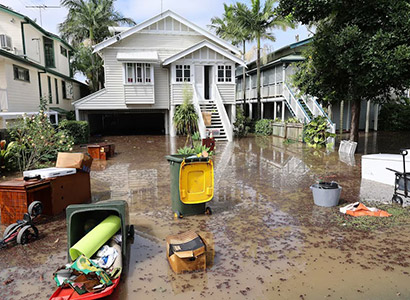Home insurance costs spike, with parts of Australia at risk of becoming uninsurable
(ABC) – In California and Florida, getting home insurance is becoming an almost impossible task.
It’s either unaffordable or in some cases not being offered at all, with insurance companies pulling out in droves.
 |
| Insurers are reducing premiums for homeowners adopting flood resilience measures.(ABC News: Tara Cassidy) |
The combination of climate-fuelled natural disasters coupled with increasing populations often living in risky areas is threatening the global insurance industry.
This isn’t theoretical for Australians. Bushfire and flood disasters during the past few years have seen insurance premiums skyrocket.
It doesn’t just affect those in disaster-prone areas; ultimately, everyone ends up footing the bill.
Skyrocketing insurance premiums were also one of the biggest contributors to inflation over the past 12 months, rising 16.4 per cent according to the latest ABS figures.
“We’ve seen in other markets around the world like California and Florida that have almost very similar profiles to Australia in terms of peril risks like flood and bushfires, as well as cyclones, a growing population has been left vulnerable and exposed,” says Insurance Council of Australia CEO Andrew Hall.
“In fact, in California, some of the major insurers are no longer offering new insurance policies for home and contents.
“We desperately need to avoid a scenario where insurance is not sustainable and insurers are pulling back.”
But there’s not much time to fix it, according to Mr Hall.
“We actually don’t have that long,” he says.
“If we talk to people in the international reinsurance markets, they tell us that Australia’s window for action is closing fast.”
Professor Paula Jarzabkowski, an expert on the insurance protection gap, from the University of Queensland, agrees.
“We are in a really serious place. It’s a tipping place, but we’re still in a good position,” she says.
But if we don’t address the insurance problem, Professor Jarzabkowski fears the impacts will be long-lasting and affect not just those in disaster areas, but a growing number of people who are simply priced out.
“The biggest risk is driving inequality in Australia,” she says.
“We are creating an underclass of people who are not served by institutions that we think work.
“That is my biggest fear because it has such a powerful societal effect and it’s a long-term effect.”
The most obvious driver of premiums is the increasing severity and frequency of major disasters fuelled by climate change, with floods and storms the most costly for insurers.
Increasing building and repair costs due to inflation are adding to the bill.
And importantly, the cost of reinsurance is also increasing — that’s insurance for insurance companies.
“For many years, Australia was considered an offset for the disasters that insurers experience in the northern hemisphere,” Mr Hall explains.
“But over the last seven years, that’s changed completely because every summer we’ve had big events.”
“We’ve seen global reinsurance premiums increase between 20 and 30 per cent, which follows a number of years of losses by reinsurers in markets like Australia and that’s having a flow-through effect.”
Unprecedented floods across the Gulf of Carpentaria caused major damage to properties in Queensland in March 2023.
Mr Hall says in Australia, households are working hard to keep paying their insurance, but increasingly people are underinsured.
“We are concerned that there is a growing protection gap and that’s driven by the higher cost of premiums driven by the underlying risk.”
A report from the Actuaries Institute last year estimated, one in eight households in Australia were facing home insurance affordability stress, following a 28 percent increase in home insurance premiums.
And a survey by consumer advocacy group Choice found 87 per cent of households said their premiums went up last year.
Looking at the United States can provide some valuable insights on what not to do, according to both Mr Hall and Professor Jarzabkowski.
(Latest Update May 2, 2024)
|